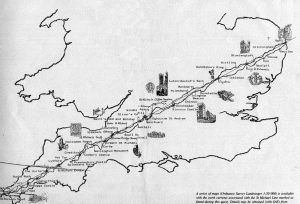Category Archives: Ley Lines
5 Steps to Ley Lines in Apparition
Ley lines (pronounced ‘lay’) are in Apparition because I wanted to pay homage to the landscape of its setting, Grey County by imagining the relationship between the land and spiritual energy. I played with the idea of ‘hallowed’ ground and roads taken on a spiritual journey, in this world or to the ‘afterworld’. Whether the reader takes it as literal or just literary is up to them. But these were the steps I travelled:
1. In the West, ‘ley lines’ were coined by an amateur British archeologist named Alfred Watkins in 1921 in a book called The Old Straight Track, when he noticed that landmarks, whether geological or cultural, often appear to be in alignment with each other. He gave examples of four or more natural and historical sites that lined up along single planes, too numerous, he argued, to be a coincidence. He connected the dots and called them ‘ley lines’, after the old English word ‘ley’ meaning a kind of trench or valley. He speculated that they represented ancient roads or trackways.
2. Popular speculation is that there are geological anomalies that point to some kind of invisible earth-energy network running along the surface of our planet, emanating from below ground. Stonehenge is believed to get its mojo from being at a crossroads between two ley lines. Sedona in Arizona is another hotbed of ley line power. Of course, lots of different cultures have parallel ideas that predate Watkins by centuries, beliefs that there are geometric or curved lines in the landscape that act like aqueducts of energy flow. Everyone from dowsers to shamans has been trying to tap into these energy lines for eons. In Chinese culture they’re called “dragon currents,” and it’s bad luck to block or disrupt them. Aborigines in Australia have song lines.
3. They’re sometimes thought of as pathways of heightened spiritual activity, roadways for the traveling souls of dead ancestors. Many spiritualists in the early 20th century believed that ley lines in Great Britain were marked by increased ghost sightings. Some pretty important people believed this, like Sir Arthur Conan Doyle, the creator of Sherlock Holmes.
4. You can find numerous maps of ley lines on the Internet, including for Southern Ontario, the setting for Apparition, but I didn’t draw specifically on any of them. I preferred to combine the idea of a ley line with an Aboriginal ‘ghost road’ instead. Ghost roads are a common element of ancient aboriginal folklore, including amongst First Nations who inhabited the Grey County region thousands of years before colonization by Europeans. Death is a journey – a literal journey by land or water to another place. Ghost roads can be identified by the increase in ghost sightings along them. (More on ghost roads to come!)
5. For some reason, I like the image of a ghost walking along a road, heading somewhere. But in Apparition, I was also imagining reasons why ghosts might not take that journey, getting trapped in ‘this world’ when they’re supposed to be on their journey to the ‘next’. And then I wondered whether sometimes they just don’t want to hit the road.
